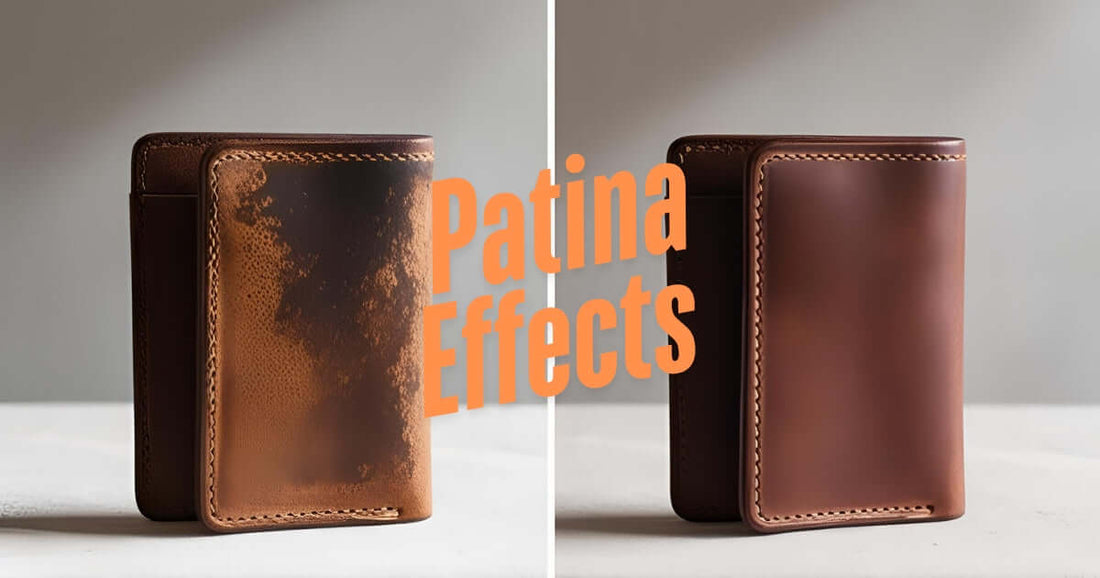
What is Patina on Leather? The Ultimate Guide to Leather Aging
Share
What is Patina?
Patina on leather is a thin, natural layer that forms on the surface of leather over time. It develops due to exposure to sunlight, air, and the natural oils and sweat from your skin. This process enhances the leather’s character, giving it a unique, rich appearance that only improves with age.
Additionally, patina on leather refers to the way its color changes over time. As leather interacts with its surroundings, it darkens and deepens in tone, creating a beautifully aged, well-worn look that many leather enthusiasts appreciate.
Patina is a natural part of the aging process, gradually transforming the appearance and texture of high-quality materials. Over time, it enhances depth, creating a richer color, a subtle sheen, and a softer, more supple feel.
What makes patina truly fascinating is its uniqueness—no two items develop the same look. Its formation depends on exposure to light, air, and everyday use, making each piece distinct and full of character.
How Does Patina Develop on Leather?
Natural leather is a living material that evolves beautifully over time, with patina forming as part of its unique aging process. This transformation is influenced by a variety of factors, which can be broadly categorized into two main areas: how the leather is used and the environment it is exposed to.
One of the defining characteristics of high-quality leather is its ability to "breathe"—absorbing moisture, oils, and environmental elements. Think about everyday leather essentials like wallets, satchels, and belts. These items are frequently touched, exposed to body oils, and come into contact with elements like sunlight and rain. Over time, these interactions leave their mark, deepening the leather’s tone, enhancing its sheen, and making each piece one of a kind.
What makes patina so fascinating is its unpredictability. No two pieces of leather age the same way. For instance, exposure to rain can create watermarks, while sunlight enhances warm golden hues. The more an item is used, the more character it develops, reflecting the lifestyle of its owner.
Key Factors That Influence Patina Development:
- Heat Exposure: Heat exposure can accelerate aging, making the leather softer and more pliable.
- Sunlight (UV Radiation): Encourages a darker, richer tone or a sun-kissed golden hue.
- Natural Skin Oils: Gradually enrich the surface, deepening color and creating a soft sheen.
- Moisture (Rain or Humidity): May cause water spots or darkening, adding to the leather’s uniqueness.
- Dye Transfer (e.g., Denim): Can subtly tint the surface, altering the original shade.
- Wear and Tear (Scratches & Scuffs): Contribute to the leather’s lived-in, vintage appeal.
Ultimately, patina is a testament to time, telling a story through its evolving texture and color. It’s what makes premium leather goods more beautiful with age—developing a richness and character that factory-made materials simply can’t replicate.
Why is Leather Patina So Desirable?
Much like a fine Scotch whisky maturing in an oak barrel, high-quality leather only gets better with time. For leather enthusiasts, patina isn’t just a natural byproduct of aging—it’s a hallmark of craftsmanship, character, and timeless appeal. But what makes the patina look so sought after? In our opinion, its allure can be traced back to three key ideas:
A Testament to Quality and Authenticity
Not all leather develops a patina—only high-quality, full-grain and top-grain leather ages in this distinctive way. A rich patina is a sign that the leather is genuine, untreated, and capable of evolving with use. This natural aging process enhances the perceived value of a product, distinguishing premium leather from mass-produced alternatives that crack and peel over time.
A Story That’s Uniquely Yours
Patina is personal. No two pieces of leather age the same way, making every patina a reflection of its owner’s lifestyle. The scratches, scuffs, sun exposure, and daily wear all add to the leather’s evolving character—telling a story that can’t be replicated. A well-patinated leather bag or wallet becomes a sentimental piece, much like a favorite pair of worn-in jeans or a treasured heirloom watch.
The Beauty of Imperfection
In a world obsessed with flawless, mass-produced goods, patina embraces imperfection as an art form. The subtle shifts in color, the deepening richness of the leather, and the soft sheen that develops over time all contribute to a raw, organic beauty that only gets better with age. It’s the opposite of disposable fashion—it’s a celebration of longevity, craftsmanship, and timeless style.
Ultimately, patina is what separates fast fashion from true investment pieces. It transforms leather from something new into something uniquely beautiful, making each bag, wallet, or belt more valuable with time.
Visual Appeal: The Timeless Beauty of Leather Patina
Aged leather carries a distinct vintage charm that is both sophisticated and highly sought after. The rich depth of patina is often associated with authenticity, craftsmanship, and timeless elegance—qualities that elevate the desirability of premium leather goods.
Freshly crafted leather items boast a pristine, uniform appearance, but their true beauty emerges over time. As they age, subtle imperfections form, colors deepen, and a natural sheen develops, creating a one-of-a-kind aesthetic that can’t be replicated.
Take, for example, a well-loved cognac leather bag—with years of use, its original hue will evolve into a deeper, richer tone, reflecting its journey and the hands that have carried it. This transformation, unique to each piece, is what makes patina so captivating. It’s not just wear—it’s character, history, and a story unfolding with every touch.
Patina: A Mark of Premium Leather
One of the key reasons patina is so desirable is that it serves as a visual hallmark of high-quality leather. Only the finest leather—sourced from the outermost layer of an animal’s hide—has the strength, durability, and natural composition to develop this rich, evolving character over time. In other words, if a leather product patinates, it’s a strong indicator that it’s made from full-grain or top-grain leather, the highest grades available.
Beyond aesthetics, patina also enhances the physical properties of leather. As it forms, it creates a protective layer that not only improves durability but also makes the leather softer and more supple to the touch. This is why premium leather goods, from wallets to satchels, don’t just last—they improve with age, becoming even more comfortable and luxurious over time.
Each Patina Tells a Unique Story
More than just a sign of aging, patina is deeply personal—it evolves based on how you use your leather goods, making each piece a reflection of your lifestyle.
Take, for example, a well-worn leather wallet. Over time, its edges darken where it’s frequently handled, absorbing the natural oils from your skin. The surface may have fine scratches from brushing against keys in your pocket, or perhaps there’s a subtle nick from the day you dropped it while rushing for a train. If it sits in a valet tray on your desk, daily exposure to sunlight might have tanned certain areas, adding depth to its color.
In essence, patina turns leather into a canvas of experiences, capturing the journey of its owner. No two pieces will ever age the same way. After five years of use, each KALGHI leather wallet will have a distinct character, shaped by its environment and the hands that carried it—and that’s something worth celebrating.
Do All Leathers Form a Patina?
The simple answer is no. Not all types of leather develop a patina, and the ability to do so is a mark of premium quality.
There are four main types of leather: full-grain, top-grain, corrected-grain, and genuine leather. However, only the two highest grades—full-grain and, to a lesser extent, top-grain leather—will naturally develop a patina over time. Lower-quality leathers, such as corrected grain and genuine leather, often undergo heavy processing, coatings, or synthetic treatments that prevent the aging process from taking place.
Tanning Method Matters
Another key factor influencing patina development is the tanning method:
- Vegetable-tanned leather is the best candidate for patina. This traditional, eco-friendly tanning process uses natural tannins from tree bark, allowing the leather to evolve, darken, and develop a rich character over time.
- Chrome-tanned leather, on the other hand, is treated with chemical compounds that lock in color and texture, preventing significant patina formation. While it remains durable, it won’t achieve the same depth or individuality as vegetable-tanned leather.
For those who appreciate the unique beauty of aging leather, full-grain, vegetable-tanned leather is the gold standard—it’s the only type that truly tells a story through patina.
